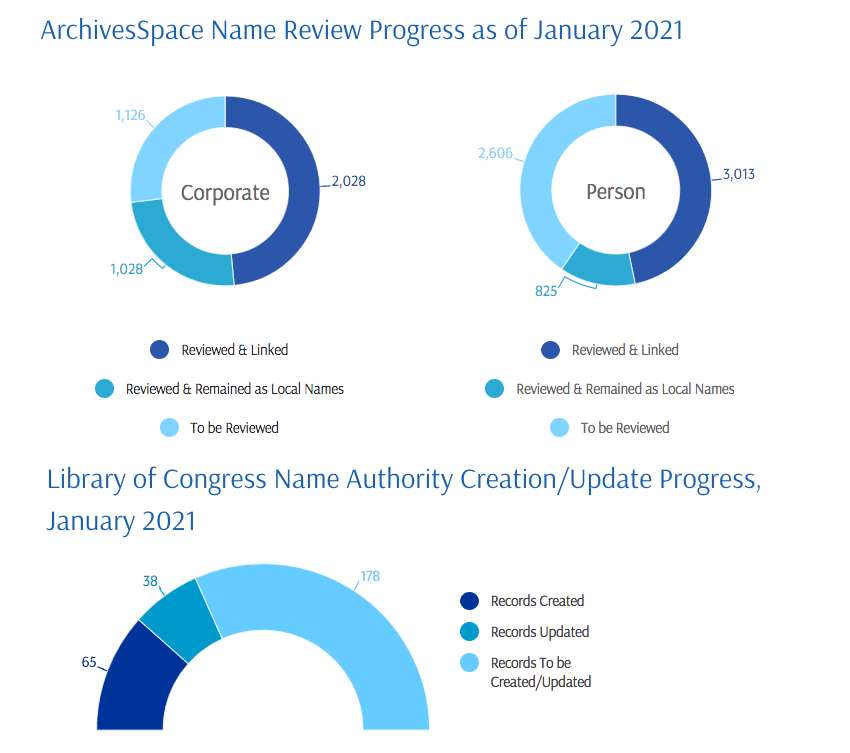One of our collaborative work-from-home projects since the COVID pandemic started in March 2020 is our ongoing review of linked authority records in our archival collections. The shared authorities in our archival collections are managed in ArchivesSpace and are utilized across four of our distinctive collections including the Avery Architectural and Fine Arts Library, the Burke Library at Union Theological Seminary, the C.V. Starr East Asian Library, and the Rare Book & Manuscript Library. These personal, family, and corporate names are linked to our archival collections as creators, sources, and subjects mentioned in the materials. Through this authority control work, it enhances the searchability and discovery of archival materials in the catalogs by maintaining consistency in the controlled vocabularies and providing additional access points to the collections.
The first step was to programmatically identify and list all names without linked authority ID from ArchivesSpace into a shared spreadsheet created by the Head of Archives, Kevin Schlottmann. From there, our public service assistants team conducted the initial check by adding the Library of Congress Name Authority ID to the spreadsheet. Kevin then ran a query matching the names and the dates with the information in the LC Name Authority File (LCNAF) to verify the match. The next step was for the archivists to review and confirm each identity based on the collections they are linked to.
During the review process, the archivists would look at a name in our ArchivesSpace record and compare it to the name in the LCNAF record. We then used online reference resources such as Wikipedia, news sites (e.g. New York Times, Newspapers.com), genealogy sites (e.g.: Find a Grave, Ancestry, Geni, etc.), as well as our archival resources and from other archival repositories to confirm whether the name in ArchivesSpace is an identical match with the identity in LCNAF based on information such as dates, locations, affiliations, and occupations. If the identities matched, we would link the LC authority ID to ArchivesSpace. Some common issues we tried to resolve during the review were misspelling, misdating, name variants, identical names but different identities, and so on. If a name in LCNAF could be updated with new information or if there was no existing authority entry, we would suggest it to be updated or created with the help of the OSMC Rare Book Cataloger, Matthew Haugen. For names with insufficient citations or information for the authority to be confirmed in LC, they would temporarily remain as a local authority until more information about the individual could be found.
We also used our language skills to search for non-English resources with more detailed information on names that are more commonly known outside of English-speaking countries. The two groups of languages that we have expertise in are Slavic languages and some East Asian languages. We noticed sometimes English sites did not have enough information to help us confirm the identity and other information on certain individuals, especially when the names were transliterated into English in some cases. One example was Kosta St. Pavlović, we have added the death date from 1946 to 1949 in his LCNAF based on the information from the Historical Archives of Belgrade webpage. Another example was Ling Hong-hsun (凌鴻勛), we have added the death date and additional information in the LCNAF based on his Chinese Wikipedia entry and his biographical on the National Chiao Tung University website. The Chinese sources contained more detailed information such as his courtesy name, birth place, education background, and his career accomplishment that did not appear in English search results. In addition, it was a challenge to find biographical/historical information on some persons, groups, organizations because certain identities are too recent, and the names would not appear on the web to protect living people’s privacy.
Overall, this project gives us an opportunity to revisit our existing finding aids while working from home and to re-link and add any additional persons or organizations related to our collections. The results of this work can help us to improve the overall searchability and discovery of archival materials in our repositories. It will also help connect the creators in our collections to those in other collections on shared platforms such as the Social Network for Archival Context (SNAC). Working on this project also allows us to take a closer look at each collection in our repositories and learn more about the people, families, organizations, and their lives and histories that are linked to the records in our care, and thus, equip us with more knowledge about our collections to better assist researches.


One thought on “Linking Names in Our Archival Collections: Shared Authority Review (Interim update)”
Comments are closed.